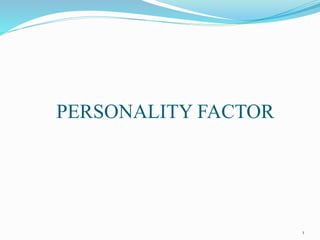
Affective domain
- 2. AFFECTIVE DOMAIN personality factors related to affective domain or intrinsic side of affectivity Affect refers to emotion or feeling. Affective Domain is the emotional side of human behavior and it may be put side by side to cognitive side. The development of affective states or feelings involves a variety of personality factors, feelings both about ourselves and about others with whom we come into contact.
- 3. Extended definition of Affective Domain Benjamin Bloom et al (1964) provided an extended definition of affective domain, outlining 5 levels of affectivity: 3 1. Receiving: a person must be aware of the environment surrounding him, be conscious of situations, phenomena, people, objects; be willing to receive, willing to tolerate a stimulus, not avoid it, and give a stimulus his controlled or selected attention.
- 4. 2. Responding: committing himself to a phenomenon or a person, a person is willing to respond voluntarily without compelling, and to receive satisfaction from that response. 3. Valuing: placing worth on a thing, a behavior or a person. A person does not only accept a value to the point of being willing to be identified with it, but commit himself to the value to pursue it, seek it out, and to want it, finally to the point of conviction. 4
- 5. 4. Organization of values into a system of beliefs, determining interrelationships among them, and establishing a hierarchy of values within the system. 5. Finally, an individual becomes characterized by and understand himself in terms of his value system. The individual acts consistently in accordance with the values he has internalized and integrates beliefs, ideas, and attitudes into a total philosophy or world view. At this level, the problem solving, for example, is approached on the basis of a total, self-consistent system. 5
- 6. Personality Factors in Human Behavior 1. Egocentric factors – one’s view of self and its relevance to language learning 2. Transactional factors – how the self is transacted to others 3. Motivational factors 6
- 7. Egocentric Factors 1. Self-Esteem 2. Inhibition 7
- 8. Self-esteem is probably the most pervasive aspect of any human behavior. It could be claimed that no successful cognitive or affective activity can be carried out without some degree of self - esteem, self confidence, knowledge of your self, and belief in your own capabilities for that activity
- 9. 1. Self-Esteem - Definition Coopersmith (1967: 4-5): defines self-esteem: 9 • The evaluation which the individual makes and customarily maintains with regard to himself; • it expresses an attitude of approval or disapproval, • and indicates the extent to which an individual believes himself to be capable, significant, successful and worthy.
- 10. Definition of self-esteem (cont) Self-esteem is a personal judgment of worthiness that is expressed in the attitudes that the individual holds towards himself. It is a subjective experience which the individual conveys to others by verbal reports and other overt expressive behavior. 10
- 11. Types of self-esteem: 1. General or Global 2. Situational or Specific 3. Task self-esteem 11
- 12. General or Global self-esteem General or global SE is thought to be relatively stable in a mature adult, and resistant to change except by active and extended therapy. 12
- 13. Task self-esteem Relates to particular tasks within specific situations (eg. Within educational domain: refers to particular subject matter areas). In athletic context, skills in a particular sport or even a facet of a sport (eg. net play in tennis). Specific self-esteem might refer to SLA in general, and task self-esteem might refer to one’s self evaluation of a particular aspect of the process: speaking, writing, or a special kind of classroom exercise. 13
- 14. Situational or specific self-esteem Refers to one’s appraisal of oneself in 14 certain life situations, such as social interaction, work, education, home, or on certain relatively discretely defined traits (intelligence, communicative ability, athletic ability), or personality traits (gregariousness, empathy, and flexibility).
- 15. 2. Inhibition The concept of inhibition is related to and subsumed under the notion of self esteem. All human beings build sets of defenses to protect the ego. The newborn baby has no concept of his own self; gradually he learns to identify a self that is distinct from others. In childhood, the growing degrees of awareness, responding and valuing begin to create a system of affective traits which the person identifies with himself. 15
- 16. Inhibition (cont) In adolescence, the physical, emotional, and cognitive changes of the pre-teenager and teenager bring on mounting defensive inhibitions to protect a fragile ego, to turn aside ideas, experiences, and feelings that threaten to take to peaces the organization of values and beliefs on which appraisals of SE have been founded. The process of building defenses continues on into adulthood. 16
